Context
Focşani is the capital city of Vrancea County in Romania on the shores of the Milcov River. The total inhabitants of Focşani City are around 73,868 as per the last census data of 2011. It is a medium dimension city with the population density of about 20.48 inhabitants/ha.
The Municipality of Focşani is the legal owner of the DH Company ENET SA, which is the operator of the cogeneration and heating plants, the transmission (23.21 trench km) and distribution network (60.93 trench km), as well as the DHW (6.093 km trench including recirculation) system in Focşani.
The main problem of this demosite is the high rate of disconnection of flats from the DH network. Over the last years, there has been a cut in DH facilities and number of users: Only 55% of the apartments where a DH connection would be possible are currently supplied with district heating.
Flats that are not connected to DHC systems have individual gas heating systems.
The reason for the low connection rate is the low amount of energy delivered per heating line length of the DH system with approx 1.02 GWh/km trench, which is far below the international DH benchmark of 2 GWh/km trench. This low value is due to the high DH losses of 36.9% (2018).
To improve the competitiveness of DH services versus individual boilers, the Focşani municipality started the modernisation and rehabilitation of the heating networks and heating sub-stations. Based on the Master Plan developed in 2009, the municipality has already successfully rehabilitated the DH system including substations and also the facilities with the installation of 2 x 6.8 MWe gas engines and a 50 Gcal/h gas boiler.
The Vrancea region has the average solar irradiation of an Eastern European country.
Vracea County has a relatively low geothermal potential. The highest renewable potential may be based on biomass, that holds 65% of the available renewable potential in Romania, with a potential of the order of 38,000 kton/year.
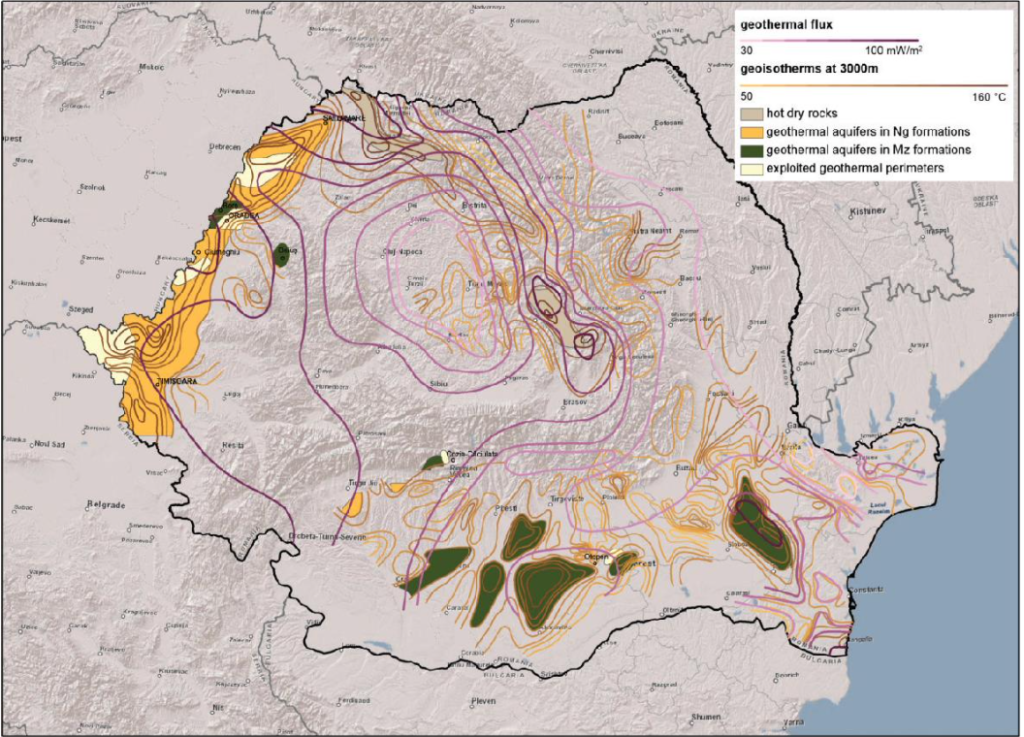
Energy demand
The energy consumption of the DH in Focşani is shown below. The total annual energy delivery of amounts to 86 GWh/y heat and 84 GWh/y of electricity sent to the grid. It is estimated that in 2050 the energy delivery will amount to 126 GWh for heat and 51 GWh of net electricity to the grid.
The addition of heat pumps for heating water in summer reduces the net electricity balance, for the switching off the gas boilers in summer, with electricity being the main input those months.
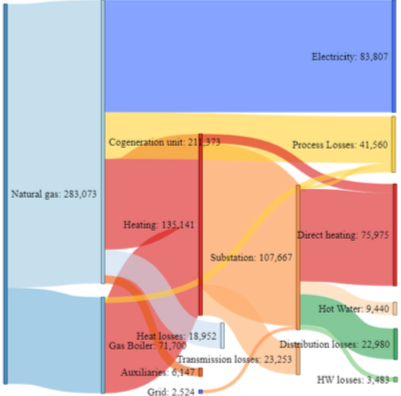
Below is the energy balance in winter and summer in 2018. There is a notable difference between the two as the gas boilers are much less used in summer, as there is no need of the direct space heating demand, but the need for cogeneration production of electricity and thermal energy for heating water remains.
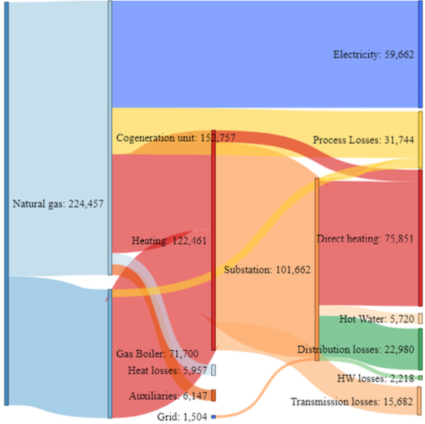
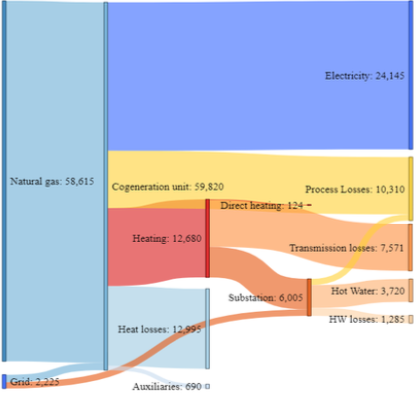
Below is the expected energy balance in 2050. It shows how the total consumption of natural gas is expected to reduce by increasing the efficiency of the system, while the total amount of end-user energy consumption increases.
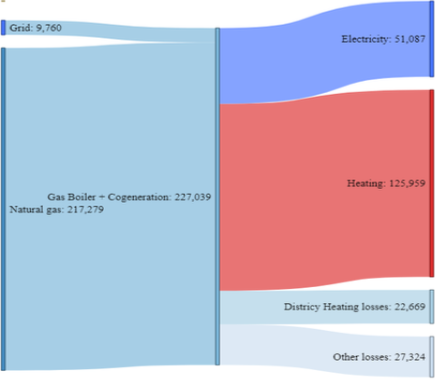
The current planned DH does not include potential cooling demand, which will be fulfilled individually by the end-users through classical mechanical cooling systems.
The external energy supply in the future is planned under the hypothesis that it will be based on natural gas and electricity from the grid, that would ideally come from cheap renewable sources. The application of technologies based on biomass, and, optionally, geothermal technologies would also be explored. The analysis of hybrid thermal-PV technologies will be evaluated as well from the analysis of the solar resource in the region, especially during the summer period.
The main impacts of the proposed alternative solution might be:
Diversification and combination of additional energy sources, giving an alternative to extend the operation of all installations to the whole year, avoiding their shutdown in winter or summer periods, or oversizing.
Extension of the facilities to develop cooling services, providing a broader portfolio of services, and stimulating the integration of more flats of the community in the network.
Proposed technologies

Advanced Absorption chiller
Compare WEDISTRICT absorption chiller with the performance of the existing single and double effect absorption chillers

Solar technologies
Integration of solar panels in the central station to cover extra heating load

Molten salt storage
Storage to support cooling options or additional services requiring T> 100 C

Biomass boiler
Biomass boilers installation for thermal energy supply

Renewable air-cooling unit (RACU)
integrated in buildings.

Hybrid PV-Geothermal
Analysis of low enthalpy geothermal support to the district heating and cooling
Proposed solutions
The combination of the different technologies generates three main solutions which will be studied in the next steps (other solutions might arise during the activity):
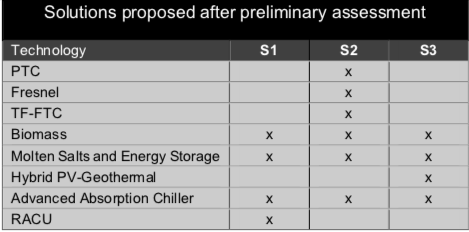
Solution 1
This combination integrates biomass with advanced WEDISTRICT cooling technologies to analyse the upgrade of the DHC.
Expected Impact
Add cooling capabilities to the system
Reduce energy differences between summer and winter
Increase the utilisation factor of existing boilers
Evaluate availability of biomass and cover extra heating load
Plan new development of residential buildings equipped with RACU
Solution 2
This combination integrates biomass and solar thermal technologies with advanced WEDISTRICT cooling technologies to analyse the upgrade of the DHC
Expected Impact
Add cooling capabilities to the system
Reduce energy differences between summer and winter
Increase the utilisation factor of existing heaters
Evaluate the possibility of additional solar thermal capabilities to the DHC
Evaluate availability of biomass and cover extra heating load
Plan new development of residential buildings equipped with RACU
Solution 3
This combination integrates hybrid PV and geothermal technologies and the additional cooling capabilities of the installation.
Expected Impact
Add cooling capabilities to the system
Reduce energy differences between summer and winter
Increase the utilisation factor of existing heaters
Evaluate the possibility of additional low-enthalpy geothermal sources and PV system
for thermal and electric balance